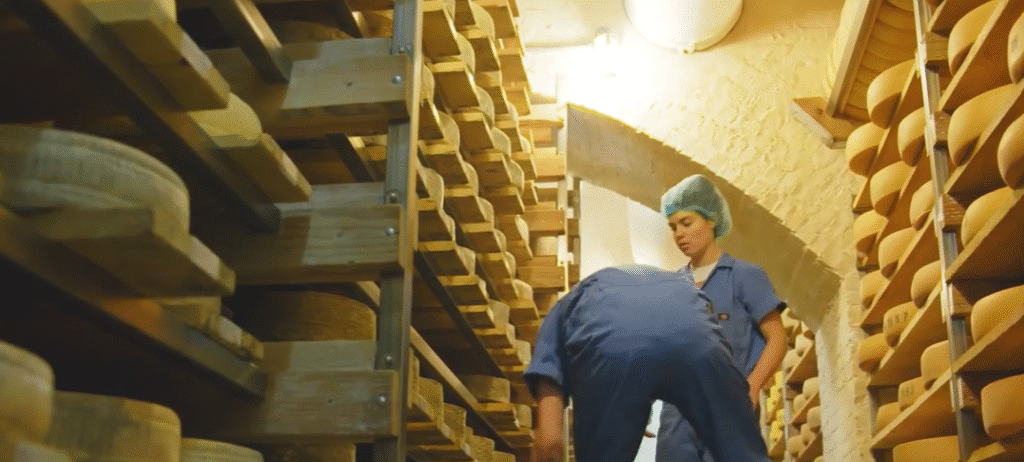A story that is both realistic and almost legendary can be found beneath Missouri’s limestone, as though the country had carved out its own chilled time capsule. Similar to enormous pantries carved out of stone, the so-called cheese caves are actually enormous underground mines that have been transformed into climate-stable warehouses. Not only do they remind us of previous government surplus programs, but they also form a very strong foundation for modern food logistics.
Perhaps the most frequently mentioned location, Springfield Underground, serves as the central theme of the story. It is a vast system of caverns that were excavated by limestone miners decades ago. The voids left over after the mining slowed provided a very obvious benefit: naturally cool air that needed little additional energy to sustain. Businesses turned the area into one of the most effective storage hubs in the nation by taking advantage of the climate’s stability. Eggs, cheese, frozen meats, and drinks have all been moved through its docks. Truck drivers talk about the unsettling rush of operating a semi underground, while employees remember the subtle scent of food blending with diesel.
The SubTropolis in Kansas City expands on the concept even further. Because of its enormous size, it resembles an underground commercial city. Pallets are routinely moved and forklifts hum on docks illuminated by rows of lights that go on forever. Rather than being a secret lair, the area may seem surprisingly mundane to a visitor, more like a huge warehouse. However, the benefit is especially advantageous: stable temperatures throughout the year drastically lower the heating and cooling expenses that above-ground warehouses frequently incur.
Table of Key Details on Missouri Cheese Caves
| Facility | Location | Size and Scale | Temperature | Operator | Uses Today | Famous Associations | Public Access |
|---|---|---|---|---|---|---|---|
| Springfield Underground | Springfield, MO | About 3.2–3.5 million square feet of warehouse space | Naturally in low 60s°F; engineered coolers around 36°F | Erlen Group | Food storage, beverages, logistics, supply chain hub | Associated with Kraft Heinz and rumors of “government cheese” | Not open for tours, industrial only |
| SubTropolis | Kansas City, MO | ~55 million square feet within 1,260 acres | Around 65°F ambient, with controlled storage options | Hunt Midwest | Mixed industrial storage including food and archives | Known as the “largest underground business complex” | Restricted; business tenants only |
| Carthage Underground | Carthage, MO | Network covering millions of sq ft; Americold manages refrigerated areas | Ambient 60°F, with dedicated refrigerated/frozen zones | Americold and others | High-capacity storage for food, eggs, and cheese | Popular among truckers and supply chain workers | No public access; active warehouse system |

Particularly when considering Americold’s activities, Carthage Underground adds another level of complexity. In this case, refrigeration is more accurate, supporting millions of eggs and frozen goods among dairy products. Employee accounts indicate that the facility is extremely adaptable, serving as both a cold storage area and an active mine. Food distribution throughout the Midwest has significantly improved thanks to this dynamic maze created by the combination of excavation and commerce.
American pop culture was solidified by the government’s surplus cheese program in the 1970s and 1980s. The administration of Ronald Reagan dispersed “government cheese” through food assistance programs, while President Jimmy Carter’s subsidies led to overproduction. A sturdy place to store the cheese was needed, and Missouri’s caves made the ideal vault. At the time, that decision was remarkably successful in preserving food while policymakers dealt with an unforeseen glut. Popular culture continues to contain references to “government cheese,” from sketches on Saturday Night Live to Kendrick Lamar and Jay-Z’s rap lyrics.
Today, Springfield Underground is no longer rented space by the USDA, and operators have made it very clear that no cheese owned by the government is housed there. But the myth persists, propelled by nostalgic tales and social media posts. Maybe it continues because the caves themselves are intrinsically enigmatic—private, concealed beneath everyday scenery, and associated with a time when politics and food security clashed dramatically.
These caves’ ongoing adaptation is what makes them so inventive. In recent times, they have housed storage for processed foods that require consistent conditions, coffee, and beverages in addition to cheese. Through strategic partnerships, businesses use these locations to reduce energy costs and free up above-ground space by streamlining operations. It is an illustration of the tremendous adaptability of infrastructure, which enhances its value well beyond its initial function.
Storage is only one aspect of the cheese caves’ social impact. They emphasize how subsidies and surpluses have frequently influenced American food policy. With the help of the government, low-income families were able to eat excess cheese, creating a shared memory of humor and adversity. The discussion is now turning once more to the paradoxical rise in cheese consumption and decline in dairy consumption. Under these circumstances, the caves represent both continuity and change.
Sustainable storage has become more popular during the last ten years. An example of how natural settings can be utilized to store perishables in incredibly durable ways is found in Missouri’s caves. When compared to traditional warehouses, the limestone walls considerably lower the energy footprint by acting as insulation. With the increasing complexity of food distribution in the years to come, these caves might be viewed as exceptionally successful models for sustainable logistics.
